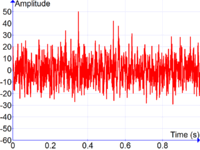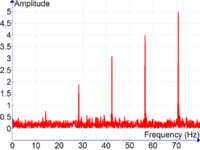Signal processing



Signal processing is an enabling technology that encompasses the fundamental theory, applications, algorithms, and implementations of processing or transferring information contained in many different physical, symbolic, or abstract formats broadly designated as signals. It uses mathematical, statistical, computational, heuristic, and linguistic representations, formalisms, and techniques for representation, modelling, analysis, synthesis, discovery, recovery, sensing, acquisition, extraction, learning, security, or forensics.[1]
History
According to Alan V. Oppenheim and Ronald W. Schafer, the principles of signal processing can be found in the classical numerical analysis techniques of the 17th century. Oppenheim and Schafer further state that the "digitalization" or digital refinement of these techniques can be found in the digital control systems of the 1940s and 1950s.[2]
Application fields

- Audio signal processing – for electrical signals representing sound, such as speech or music
- Speech signal processing – for processing and interpreting spoken words
- Image processing – in digital cameras, computers and various imaging systems
- Video processing – for interpreting moving pictures
- Wireless communication – waveform generations, demodulation, filtering, equalization
- Control systems
- Array processing – for processing signals from arrays of sensors
- Process control – a variety of signals are used, including the industry standard 4-20 mA current loop
- Seismology
- Financial signal processing – analyzing financial data using signal processing techniques, especially for prediction purposes.
- Feature extraction, such as image understanding and speech recognition.
- Quality improvement, such as noise reduction, image enhancement, and echo cancellation.
- (Source coding), including audio compression, image compression, and video compression.
- Genomics, Genomic signal processing [3]
In communication systems, signal processing may occur at:
- OSI layer 1 in the seven layer OSI model, the Physical Layer (modulation, equalization, multiplexing, etc.);
- OSI layer 2, the Data Link Layer (Forward Error Correction);
- OSI layer 6, the Presentation Layer (source coding, including analog-to-digital conversion and signal compression).
Typical devices
- Filters – for example analog (passive or active) or digital (FIR, IIR, frequency domain or stochastic filters, etc.)
- Samplers and Analog-to-digital converters for Signal acquisition and reconstruction, which involves measuring a physical signal, storing or transferring it as digital signal, and possibly later rebuilding the original signal or an approximation thereof.
- Signal compressors
- Digital signal processors (DSPs)
Mathematical methods applied
- Differential equations
- Difference equations
- Transform theory
- Time-frequency analysis – for processing non-stationary signals[4]
- Spectral estimation – for determining the spectral content (i.e., the distribution of power over frequency) of a time series[5]
- Statistical signal processing – analyzing and extracting information from signals and noise based on their stochastic properties
- Linear time-invariant system theory, and transform theory
- System identification and classification
- Calculus
- Vector spaces and Linear algebra
- Functional analysis
- Probability and stochastic processes
- Detection theory
- Estimation theory
- Optimization
- Numerical methods
- Time series
- Data mining – for statistical analysis of relations between large quantities of variables (in this context representing many physical signals), to extract previously unknown interesting patterns
Categories
Analog signal processing
Analog signal processing is for signals that have not been digitized, as in legacy radio, telephone, radar, and television systems. This involves linear electronic circuits as well as non-linear ones. The former are, for instance, passive filters, active filters, additive mixers, integrators and delay lines. Non-linear circuits include compandors, multiplicators (frequency mixers and voltage-controlled amplifiers), voltage-controlled filters, voltage-controlled oscillators and phase-locked loops.
Continuous-time signal processing
Continuous-time signal processing is for signals that vary with the change of continuous domain(without considering some individual interrupted points).
The methods of signal processing include time domain, frequency domain, and complex frequency domain. This technology mainly discusses the modeling of linear time-invariant continuous system, integral of the system's zero-state response, setting up system function and the continuous time filtering of deterministic signals
Discrete-time signal processing
Discrete-time signal processing is for sampled signals, defined only at discrete points in time, and as such are quantized in time, but not in magnitude.
Analog discrete-time signal processing is a technology based on electronic devices such as sample and hold circuits, analog time-division multiplexers, analog delay lines and analog feedback shift registers. This technology was a predecessor of digital signal processing (see below), and is still used in advanced processing of gigahertz signals.
The concept of discrete-time signal processing also refers to a theoretical discipline that establishes a mathematical basis for digital signal processing, without taking quantization error into consideration.
Digital signal processing
Digital signal processing is the processing of digitized discrete-time sampled signals. Processing is done by general-purpose computers or by digital circuits such as ASICs, field-programmable gate arrays or specialized digital signal processors (DSP chips). Typical arithmetical operations include fixed-point and floating-point, real-valued and complex-valued, multiplication and addition. Other typical operations supported by the hardware are circular buffers and look-up tables. Examples of algorithms are the Fast Fourier transform (FFT), finite impulse response (FIR) filter, Infinite impulse response (IIR) filter, and adaptive filters such as the Wiener and Kalman filters.
Nonlinear signal processing
Nonlinear signal processing involves the analysis and processing of signals produced from nonlinear systems and can be in the time, frequency, or spatio-temporal domains.[6] Nonlinear systems can produce highly complex behaviors including bifurcations, chaos, harmonics, and subharmonics which cannot be produced or analyzed using linear methods.
See also
- Audio filter
- Delay (audio effect)
- Dynamic range compression, companding, limiting, and noise gating
- Information theory
- Reverberation
- List of music software#Music mining software
Notes and references
- ↑ Moura, J.M.F. (2009). "What is signal processing?, President's Message". IEEE Signal Processing Magazine. 26 (6). doi:10.1109/MSP.2009.934636.
- ↑ Oppenheim, Alan V.; Schafer, Ronald W. (1975). Digital Signal Processing. Prentice Hall. p. 5. ISBN 0-13-214635-5.
- ↑ Anastassiou, D. (2001). Genomic signal processing. IEEE.
- ↑ Boashash, Boualem, ed. (2003). Time frequency signal analysis and processing a comprehensive reference (1 ed.). Amsterdam: Elsevier. ISBN 0-08-044335-4.
- ↑ Stoica, Petre; Moses, Randolph (2005). Spectral Analysis of Signals (PDF). NJ: Prentice Hall.
- ↑ Billings, S. A. (2013). Nonlinear System Identification: NARMAX Methods in the Time, Frequency, and Spatio-Temporal Domains. Wiley. ISBN 1119943590.
External links
- Signal Processing for Communications – free online textbook by Paolo Prandoni and Martin Vetterli (2008)
- Scientists and Engineers Guide to Digital Signal Processing – free online textbook by Stephen Smith
- Signal Processing Techniques for Determining Powerplant Characteristics
- The IEEE Signal Processing Society
- Bio-Medical Signal processing at a Glance